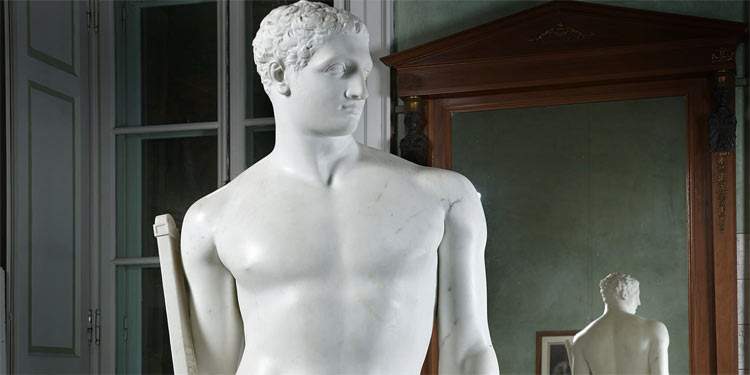On the occasion of the second centenary of the death of Antonio Canova (Possagno, 1757 - Venice, 1822), Villa Carlotta in Tremezzo is celebrating the legacy of one of the greatest masters of sculpture of all time, who was able to transform the very idea of sculpture and its technique, to create immortal masterpieces that became popular and were reproduced all over the world. The first initiative of the Canova at Villa Carlotta 1822/2022 program is the dossier exhibition dedicated to Palamedes, which will open on Thursday, April 28, and will remain open until June 5, to be followed by other activities aimed at exploring Canova’s universe through the masterpieces housed at Villa Carlotta: from the Palamedes to the original plaster cast of the Muse Tersicore, to the antique copies of Cupid and Psyche and the Penitent Magdalene.
The exhibition dossier Antonio Canova’s Palamedes revolves around the symbolic work of Villa Carlotta and intends to invite the public to embark on an unprecedented journey to rediscover the author, through a comparison of the museum’s works and some important loans, from public and private collections. Courted by the powerful, idolized by collectors from half of Europe, wealthy travelers who passed through his workshop in Rome during the Grand Tour, Canova knew how to make himself the interpreter of the classical ideal in works of great charm and surprising modernity, in that era of great changes marked by the French Revolution and the Napoleonic regime.
The exhibition opens with an exceptional loan, Andrea Appiani’s Portrait of Giovanni Battista Sommariva from the Accademia Carrara in Bergamo, which admirably translates-between lights and shadows-the image of the former owner of Villa Carlotta, a powerful politician in the service of Napoleon Bonaparte and reckless businessman, but above all a refined collector of Canova’s works. In his fulminating political parabola, abruptly interrupted by the accusation that he derived his immense wealth from unscrupulous economic speculation, one could easily project the story of Palamedes, unjustly accused of treason by Ulysses and sentenced to death.
It would be Canova who would consign to immortality this hero of the Trojan War, inventor of dice, chess and the alphabet, who was forgotten by Homer. From drawings (originals and reproductions) through ancient books that suggested the artist’s inventions, the exhibition recounts the events that led to the birth of an exciting masterpiece, the result of one of the most intense dialogues of all time between patron and artist. Among the works on display, in fact, are the highly refined illustrated edition, printed by Giambattista Bodoni, of Gherardo De Rossi’s work, “Scherzi poetici e pittorici,” which bears Vincenzo Monti’s dedication “Al Sig.r Count Sommariva,” and Philostrato’s “Opera Omnia,” published in Leipzig in 1709, from which Canova derived the hero’s story. This is a fascinating testimony to the bibliophile Sommariva’s collecting passion and his contacts with the literary circles of the time, suggesting his familiarity with those literary sources from which Canova’s sculptures originated. Also on display in the exhibition will be engraver Pietro Bettellini ’s print based on a drawing by Jean Baptiste Joseph Wicar reproducing Canova’s Palamedes, donated to Villa Carlotta for this very important occasion by Trippini Stampe antiche.
The sculpture’s fortune is evidenced by the fine collection of plaster casts, taken from engraved gems, engravings, and period photographs. The exhibition closes with a series of images of the Palamedes in its placement in the Marble Hall, in one in the spectacular arrangement commissioned by Duke George II of Saxony Meiningen that was maintained until the early 2000s, when the work was set up in a room entirely dedicated to it, between two mirrors, as its former owner had wanted it.
As an additional moment of insight, Villa Carlotta’s educational services are offering two guided tours entitled Canova at work, scheduled for Saturday, April 30, and Saturday, May 28, at 3 p.m., which can be booked from the website through the LINK online ticketing service. Visits to the exhibition are included in the entrance fee to Villa Carlotta, which is open Monday through Sunday, 10 a.m. to 7 p.m. (ticket office closing at 6 p.m. and museum closing at 6:30 p.m.). To avoid queues at the entrance, it is possible to take advantage of the “fast track” by purchasing the ticket online. For all information you can visit the Villa Carlotta website.
Pictured is a detail of Canova’s Palamedes.
 |
| An exhibition-focus on Canova's Palamedes at Villa Carlotta (Tremezzo). |
Warning: the translation into English of the original Italian article was created using automatic tools. We undertake to review all articles, but we do not guarantee the total absence of inaccuracies in the translation due to the program. You can find the original by clicking on the ITA button. If you find any mistake,please contact us.